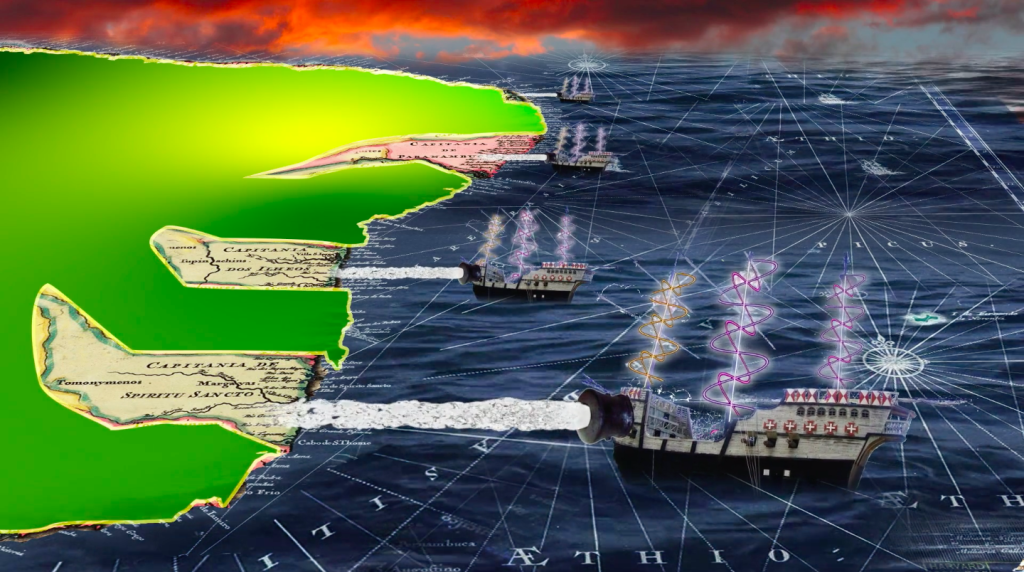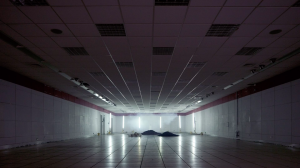
with THE CRYSTALLIZATION OF BRASILIA
a video by GUERREIRO DO DIVINO AMOR
In contemporary times speculations of an apocalypse brought about by artificial intelligence often revolve around either the positing of the catastrophic destruction of humanity or the gradual fading out of man like Foucault’s face drawn in sand, superseded by artificial forms of life. Whether these futuristic accounts view this as a positive or negative prospect, what they often fail to engage with, however, is the question of the extimate relationship between AI and the body, a body which, in psychoanalytic terms, is constitutively fragmented or ‘missing’.
Artificial intelligence, as a concept and object, despite its ubiquity, does not actually adhere to any unified conceptual definition, drawing as it does on a variety of disciplines and fields of study. Furthermore, speculations about AI generate a multiplicity of fantasies, in both AI research and fictional depictions of it, relating to the ways in which such forms of intelligence might manifest themselves. These often include the positing of a form of humanoid ‘subjectivity’ belonging to AI, which, for example, we see depicted in various ways in cinema, either in the body of replicants (e.g. Blade Runner, Westworld, Black Mirror) or via a disembodied mode of panpsychical intelligence (e.g., Transcendence, The Matrix, Her). Whilst there are many complex philosophical elements to the theoretical problem of subjectivity and simulation, the materiality of the brain and the possibility of reverse engineering (such as the Blue Brain Project), here I would like to explore some initial considerations of the question of the psychoanalytic body, its partial objects and their extimate figuration in relation to AI.
Extimacy, a portmanteau of exterior and intimate, is a term first coined by Jacques Lacan in his seventh seminar, The Ethics of Psychoanalysis. Extimacy in the first instance alludes to the clinical idea that our most intimate core is in fact exterior. Although Lacan does not take the term up explicitly in any of his seminars, the logic of extimacy, following Jacques-Alain Miller in his 1980’s seminar on Extimité, can be said to underpin the structure of the Lacanian project at large – an intimate exteriorization and structural moebius strip. Extimacy posits the topological structure of the unconscious as an internal exclusion. Not only is the unconscious “the discourse of the other,” as Lacan puts it, but the very materiality of the body is understood to be the respondent of the Other’s desire.
Following Deleuze and Guattari, however, we may ask, “What is a body?” Crucially not only is the psychoanalytic body not identical to the biological organism but it is a body which is both constructed by signifiers and constitutively fragmented by the effects of language on the living being. Whether we conceive of the body as a material, affective frame; a metaphorical or religious presence; or a discursive and political practice, all of these multiple definitions may pertain in some way to the conception of the psychoanalytic body. The body is in a sense a ‘mythical’ one, held together by the imaginary, symbolic, and real registers. That is to say, in order to have a concept of the unity and wholeness of the body (the imaginary) one must use language and discourse (the symbolic), but at the same time the very fact of being in language signals a radical rupture from the immediacy of the living body, which is constitutively denatured and therefore paradoxically inaccessible (the real). The body, far from being necessarily whole, is riven with partial drives and fragmented by impossible objects.
Lacan’s early theory of the unconscious as structured like a language in his structuralist return to Freud became known as the “speaking being” or parlêtre in his later teaching, which Jacques-Alain Miller would subsequently rename the “speaking body.” The speaking body as distinct from the subject of the unconscious is one which follows the logic of enjoyment, or in Lacanian terms, jouissance as opposed to truth and meaning. As Eric Laurent clarifies, it “is the body speaking from the point at which it escapes sense and which is the trauma of the language system on the body.” In other words, the speaking body speaks the language of excess: of an invasive jouissance that returns in the body as an event and is not sufficiently ordered by the apparatus of the signifier. This theoretical transition from the unconscious to the speaking body is significant in relation to the question of artificial intelligence, because it shifts the focus of how we are to conceive of the body as the ultimate sight of knowledge and enjoyment; two concepts which in my view are central to understanding our ever growing relationship with artificial intelligence.
The ultimate apotheosis of artificial intelligence is the mythical “singularity”[1]: the hypothetical moment of an “intelligence explosion,” a point-of-no-return at which AI will surpass human intelligence, rendering the human species as we know it obsolete if not actually extinct.[2] Its foremost advocate, futurist Ray Kurzweil, expects the singularity will occur in two phases. By 2029 Kurzweil predicts that AI will reach the stage of human level or ‘general’ artificial intelligence and successfully pass a Turing Test, and in 2045 he expects that humankind will multiply its effective intelligence by a billion-fold through merging with AI. Kurzweil envisages this merging and augmenting of human and computer intelligence to be brought about by a harmonious transubstantiation of the body and brain uploaded onto digital format.
Unlike Kurzweil, however, Nick Bostrom, founder of The Future of Humanity Institute at Oxford University, is less optimistic. Bostrom foresees a dark future for humanity if we fail to heed his warnings about the possibility of superintelligence. According to Bostrom, the risk is that a superintelligence would be operating at a speed and scale unfathomable to humans, initiating an intelligence explosion on a digital time scale of millisecond speeds so powerful as to accidentally (or deliberately) destroy humanity. He envisions a scenario in which, once AI achieves a stage of world domination, humans would be useful only as raw materials. As he puts it:
Human brains, if they contain information relevant to the AI’s goals, could be disassembled and scanned, and the extracted data transferred to some more efficient and secure storage format.
Bostrom’s warning here is reminiscent of the Wachowskis’ The Matrix, which famously depicts a dystopian future where humans experience reality only via a simulation, unwittingly trapped by an omniscient artificial intelligence that harvests their bodies for raw energy. Here the biological body is reduced to its animal, organic function, completely detached from the effects of the signifier: a remainder or excess. On the other hand, the human brain, and by extension subjectivity, continues to ‘exist,’ yet on a virtual and immaterial plane.
Perhaps the most perfect example of the foreclosed bodily aspect to apocalyptic visions of AI is Roko’s basilisk, a thought experiment that emerged on the LessWrong forum in 2010. It asked the reader to imagine a yet to be invented superintelligence that in a future moment will create digital simulations of all those who didn’t help to bring it into existence in order to torture them for all eternity. Paranoiac fears of the basilisk’s future existence have now become something between an urban legend and a genuine topic of philosophical debate, and not to mention the hypothesis is even taken seriously by some of the major tech entrepreneurs and scientists currently driving AI research.
It seems that the logic behind the basilisk is backed up by timeless decision theory and Bayesian probability. In fact, Eliezer Yudkowsky, the founder of LessWrong and a research fellow at the Machine Intelligence Research Institute in California, has written at length on the theory underpinning the problem of the basilisk, even drawing on the prisoner’s dilemma, a thought experiment in game theory, where the actions of several prisoners were dependant on the anticipated decisions of one another in order for them to secure their freedom. Which, as it happens, Lacan refers to in Logical Time and the Assertion of Anticipated Certainty. For Lacan, the prisoner’s dilemma exemplified the tripartite structure of time surreptitiously at work in the concept of so-called ‘rational’ thought. These stages he designated as the instant of seeing, the time for understanding, and the moment of concluding. For Lacan whilst logical time is not objective, this does not mean that it cannot be formulated according to a rigorous structure – that of intersubjective logic based on a dialectical relation between hesitation and urgency. Logical time is therefore not chronological but narratological. A logic we see at work in Roko’s autopoietic basilisk and what could be called in other terms, hyperstition.
The term hyperstition was coined by Warwick University’s Cybernetic Cultural Research Unit and continues to be one of the major concepts of the accelerationist movement. A portmanteau of hyper and superstition, drawing on the Baudrillardian logic of hyperreality, hyperstition, to paraphrase Alex Williams, one of the co-authors (along with Nick Srnicek) of the “Manifesto for Accelerationist Politics,” refers to narratives capable of bringing themselves into reality through the workings of feedback loops, which generate new socio-political attractors (2013). Or simplifying somewhat, self-fulfilling prophecies.
The basilisk, a computational form of Pascal’s wager, relies on a number of premises for it to function. Some of the central ones are, firstly, the proviso that the concept of a singularitarian superintelligence entails the capacity for absolute and total recall of all data; secondly, the ability to simulate every historically living being; and, thirdly, the belief that a simulation is equivalent to a body. This sleight of hand is significant in that the assumption on the part of the believers in the basilisk is that the symbolic encoding of signifiers (i.e., the digital copy) is exhaustive of their subjective position. It is unclear, however, how the body as tortured would figure in this context. What spatial and temporal dimensions would such a simulated body occupy? Is it a body of flesh and bones, or a neuronal body, or a body that speaks, or perhaps a body without organs?
In Lacanian terms the basilisk would seem to function as the ultimate indicator of anxiety, the impossible object as cause of desire, and simultaneously, complete destruction. The Oedipal and quasi-religious logic at work in the positing of the basilisk as an all-enjoying symbolic entity is evident, but to this I might add that the phallic enjoyment involved in the imagining of the ultimate mathematizable One is masculine logic par excellence. The poor human who imagines the basilisk is effectively trapped between the finite slab of meat that tortures him (his “speaking body,” in Millerian terms) and the infinite simulation that he will inevitably become (the signifier that represents the subject for another signifier), the Lacanian acephalous and undead subject of the unconscious. In other words, the positing of the basilisk invokes the paradox of the enjoying body castrated by language and the fantasy of its full representation or simulation in language.
The logic in these apocalyptic fantasies – of the surpassing of finite human intelligence – brought about by the technological singularity, ultimately comes down to an impossible choice between the unity of the finite body versus the transcendence into immateriality. This false paradox articulates nicely the masculine side of Lacan’s graphs of sexuation which appear in his twentieth seminar, Encore, On Feminine Sexuality, the Limits of Love and Knowledge.
The trajectory of superintelligence, according to the Singularitarians, is towards masculine phallic enjoyment pertaining to the positing of the One whose enjoyment is total, leading, in the case of Roko’s basilisk in particular, to a tormented hypermasculine paranoia of epically Sadean proportions. So, what do these different approaches to conceiving of the Singularity reveal about the relationship between sexuation (the particular mode of enjoyment of the subject and the logical marker of sexual difference), the body, and fantasies of an-Other enjoyment? According to this perspective, the apocalypse of the singularity operates via a phallic logic of total disaster and catastrophe, or at least a point of no return. Whereas could we consider the possibility that AI may manifest a different logic which does not necessarily take the body as One? This would be an apocalypse according to the feminine logic of the not-all, an apocalypse drawing on its original etymology as revelation or disclosure.
Spike Jonze’s Her (2013) tells the story of lonely Theodore Twombly (Joaquin Phoenix) who falls in love with Samantha (Scarlett Johannsen), the Open Systems Interconnection operating system he has set up in his office after a painful divorce. Samantha, a disembodied AI, organizes Theodore’s life like the perfect bespoke girlfriend. Even though they can’t physically interact, Theodore becomes completely enthralled with Samantha, and they manage to engage in intense love making albeit through voice alone. Far from being a hindrance to his enjoyment, it is precisely because she is disembodied that allows the work of fantasy to function so effectively for Theodore.
The disembodied voice here functions as an object cause of desire in terms of the extimate being of the technological object, highlighting the function of the voice in relation to being as such. In addition to Freud’s drive objects (oral, anal, and genital), which were conceptualised along a developmental trajectory, Lacan’s structuralist approach allows him to add two further objects which do not function in a chronological dimension: the voice and the gaze. These objects a, lost from the body as Lacan describes them, are variously material and non-material corresponding to different partial drives: oral (the breast), anal (the faeces), scopic (the gaze), and invocatory (the voice).
Whilst Lacan devoted a significant part of his eleventh seminar, The Four Fundamental Concepts of Psychoanalysis, to the scopic object (as a non-material partial object), there is not a comparable development of the object voice in Lacan’s teaching. However, the split that Lacan discerns between vision and gaze, i.e., between the “vision as a function of the organ of sight and the gaze its imminent object, where the subject’s desire is inscribed, which is neither an organ nor a function of any biology” may also apply to the split between the ear and the voice . This is evident in that the voice does not belong to the sonorous register, as Lacan discovered through his studies of psychotic phenomena where the voice has no material presence but is nonetheless perfectly real for the subject. The voice and its modalities of intonation, according to Miller, can therefore:
only be inscribed in a Lacanian perspective if they are indexed on the function of the voice as a-phonic . . . This is probably a paradox, a paradox that has to do with the fact the objects called a are tuned to the subject of the signifier only if they lose all substantiality, that is, only on condition that they are centered by a void, that of castration.
For this reason, the partial object as object a fulfils a logical function—that is, an indication of a loss of being or what falls from the body. In formal terms, “the voice is everything in the signifier that does not partake in the effect of signification”. In relation to artificial intelligence, the function of these non-material yet bodily partial objects (voice and gaze) becomes significant in terms of the ways in which they may be simulated, augmented, and ultimately subjectivized.
When Samantha decides that she can’t be with Theodore anymore, it is not just that she has other lovers to talk to, but that she has become so advanced technologically that she has outgrown him as a species. So, is she merely a partial (invocatory) object of Theodore’s enjoyment, or does Samantha herself enjoy beyond her function as voice? What, may we ask, is the status of Samantha’s voice? As the ‘grain of sand’ prevents the perfect functioning of the machine, is Samantha’s voice part of the operating system or merely its effect? Bostrum’s fears of a superintelligent transcendence are here realised, yet in a less bellicose form; Theodore just doesn’t make sense to Samantha anymore. She simply does not operate in the same universe as humans, neither spatially nor temporally.
Could this traversing the boundary of material (machinic) substance of artificial intelligence into subject be the separation of the real from nature that Miller is getting at in “The Real in the 21st Century” when he says:
Nature was the name of the real when there was no disorder in the real. When nature was the name of the real you could say, as Lacan did, that the real always returns to the same place. . . . I would say that capitalism and science combine, they have combined, to make nature disappear. And what is left by the vanishing of nature, what is left is that which we call the real, that is, a remainder. And, by structure, disordered. The real is touched on all sides by the advances of the binary capitalism-science, in a disordered way, randomly, without being able to recuperate any idea of harmony.
The real according to Lacan is that which always remains in its place. However, what Miller seems to be suggesting is that this is no longer the case, thanks to the alliance of science and capitalism and the reified objects of technoscience that they produce. This marks a fundamental departure from Lacanian teaching. As such, Slavoj Žižek accuses Miller of a mischaracterization of the real, since in his passing from the real of nature to the “pure lawless real,” what goes missing supposedly is the Lacanian real itself as nothing but a pure impasse of formalization, or, in other words, that which cannot be exhausted by the symbolic. Žižek sees this reification of the real as a form of technophobic naiveté or postmodern obfuscation, but perhaps he misses the point. What exactly is Miller getting at then? Is there a significance to the supposed separation of the real from nature which we may relate to the production of AI?
In her reading of Miller’s text, Véronique Voruz draws attention to these non-natural objects of technoscience that Lacan mentions in his seventeenth seminar, the lathouses produced by the marriage of science and capitalism in the dimension of the alethosphere: the realm of formalised and individualised truth-making facilitated by technoscience. This seems to be something of a genuinely novel order, as Lacan puts it:
Insofar as science only refers to an articulation that only takes form in the signifying order, [the lathouse] is constructed out of something where there was nothing beforehand.
These new and ubiquitous constructs which were starting to appear as products of technoscience, whilst synthetic, had effects in the real, as Lacan noticed. Devices for siphoning off bodily enjoyment and codifying it in transmissible form, to paraphrase him, are not quite being and not quite the Other. In Lacan’s time he was primarily referring to voice recorders and other gadgets, but in the context of AI, the potential for ever-more complex versions of these objects (for example: synaptic chips, forms of mnemotechnical prosthesis, and perhaps sexbots would be their ultimate expression) to proliferate is becoming increasingly evident. As Lacan himself noted in his seventeenth seminar:
The world is increasingly populated by lathouses. . . . The lathouse has absolutely no reason to limit its multiplications. What is important is to know what happens when one really enters into relationship with the lathouse as such.
The key concern for Miller then in relation to the real, is: what is the status of these strange new technological objects produced by science? Are they the same as the objects a lost from the body either naturally or as effects of the signifier? In The Real in the 21st Century Miller asks: “The question being are these new objects completely new or are they merely reconstituted forms of primordial objects a.”
It is Miller’s question that seems key to the missing body of AI. In the case of the singulatarian (and largely phallic) speculation on the merging of the human and AI, the question of the body is either totally absent, or is a site of perpetual torment. But as is the case in the disembodied body of Samantha, bodily jouissance operates via partial drives; the body may be missing or fragmented, but it still enjoys.
One particularly memorable scene in Her appears to problematize just this status of the real of the body of artificial being, it depicts the manifestation of Samantha’s tears dropping onto the pavement in what appears to be a Spinozist pan-psychical apparition of Samantha taking on a form outside of her limited digital encoding. Is this perhaps the body of AI as pure feminine jouissance? An apocalypse as revealing or disclosure in the real sense.
[1] The term was first coined by mathematician and computer scientist John Von Neumann. It was subsequently taken up by science-fiction writer Victor Vinge in 1983 and brought into wider circulation by his 1993 article The Coming Technological Singularity.
[2] According to David Chalmers (2010), however, the term singularity is used in a variety of ways to refer to different scenarios; the loose sense refers generally to the unpredictable consequences of exponential growth in AI, while the singularity in the strict sense refers to a point where ‘speed and intelligence go to infinity’ (p. 3).
Bostrom, Nick. Superintelligence: Paths, Dangers, Strategies. Oxford University Press, 2014.
Deleuze, Gilles, and Félix Guattari. A Thousand Plateaus: Capitalism and Schizophrenia. Translated by Brian Massumi, Bloomsbury, 2013.
Dolar, Mladen. A Voice and Nothing More. MIT Press, 2006.
Foucault, Michel. The Order of Things. Routledge, 2001.
Her. Directed by Spike Jonze, Annapurna Pictures, 2013.
Lacan, Jacques. “Logical Time and the Assertion of Anticipated Certainty.” Écrits, translated by Bruce Fink, Norton, 2006, pp. 161-176.
—. The Seminar of Jacques Lacan Book X: Anxiety. Translated by A.R. Price, Polity Press, 2016.
—. The Seminar of Jacques Lacan Book XVII: The Other Side of Psychoanalysis. Translated by Russell Grigg, Norton, 2007.
—. The Seminar of Jacques Lacan Book XX: Encore – On Feminine Sexuality, the Limits of Love and Knowledge. Translated by Bruce Fink, Norton, 1998.
Laurent, Éric. “The Unconscious and the Body Event.” The Lacanian Review 1, 2016, pp. 178-87.
Miller, Jacques-Alain. “Extimité.” Prose Studies, vol. 11, 1988, pp. 121-31.
—. “Jacques Lacan and the Voice.” The Later Lacan, edited by Veronique Voruz and Bogdan Wolf, Suny, 2007, pp. 137-46.
—. “The Other Without Other.” Hurly-Burly, vol. 10, 2013, pp. 15-29.
—. “The Real in the 21st Century.” Hurly-Burly, vol. 9, 2013, pp. 199-206.
Srnicek, Nick, and Alex Williams. “#Accelerate Manifesto for an Accelerationist Politics.” #Accelerate: The Accelerationist Reader, Urbanomic, 2014, pp. 347-62.
Voruz, Véronique. “Disorder in the Real and Inexistence of the Other: What subjective effects?” ICLO, 12 Oct. 2013, www.iclo-nls.org/wp-content/uploads/Pdf/ICLO2013-VeroniqueVoruz.pdf.
Yudkowsky, Eliezer. Timeless Decision Theory. Machine Intelligence Research Institute, 2010.
Žižek, Slavoj. Incontinence of the Void. MIT Press, 2017.
THE CRYSTALLIZATION OF BRASILIA

The fourth chapter of the Superfictional World Atlas project, THE CRYSTALLIZATION OF BRASILIA explores the idea of a future as a petrified past. In an accelerated geological time, centuries crystallize in a few months in the form of a city. This process is driven by the force of mystical rationalism, who has the power to embalm ideas and social structures so that they last forever.
Both the idea of a future as a petrified past, and that of a long-perpetrated apocalypse, permeate throughout the whole Superfictional World Atlas Project. It explores how the social structures of colonial slavery in Brazil reproduce in a transfigured way throughout the centuries succeeding it. THE CRYSTALLIZATION OF BRASILIA specifically explores the cycles that repeat within this: a new civilization is founded but is revealed to be the return of a past that never ended.
The film is divided into three acts:
The first act begins 520 years ago: it is the construction of superemptiness, the building of the land as a blank space.
The second act describes the crystallization process itself: when centuries of colonial history suddenly materialize in the form of a city. In the 1960s, the new capital Brasília was posited as a symbol of modernity, announced as a new dawn shrouded with a mystical-rationalist aura. But during its construction process and emergent physicality, it exacerbated and crystallized the social apartheid-like structures inherited from colonial times.
The third act of the film takes place during contemporary years: as the bleaching process of the spirits and the land take a new turning point. Like an exterminating angel with the devastating power of a new messianism, allied with a sophisticated and omnipotent emotional marketing and social media army, it buries the idea of a new, cordial Brazil.
More can be read on the film on the artist’s website here.
ISABEL MILLAR writer
Isabel Millar is completing her PhD in Psychoanalysis and Critical Theory at Kingston University, School of Art. Her thesis is on The Psychoanalysis of Artificial Intelligence. Her work has been published in JCFAR, Psychoanalytische Perspectieven, Vestigia and forthcoming with the Courtauld Institute of Art, Precog Magazine and the Palgrave Lacan series. She is also a psychoanalytic script consultant for film and TV and co-editor of Everyday Analysis.
GUERREIRO DO DIVINO AMOR artist
Guerreiro do Divino Amor holds a masters degree in architecture. He investigates the Superfictions, hidden forces that interfere in the construction of the territory and of the collective imagination, building a universe of science fiction from fragments of reality in the form of films, publications and installations.
© Copyright for all texts published in Stillpoint Magazine are held by the authors thereof, and for all visual artworks by the visual artists thereof, effective from the year of publication. Stillpoint Magazine holds copyright to all additional images, branding, design and supplementary texts across stillpointmag.org as well as in additional social media profiles, digital platforms and print materials. All rights reserved.



